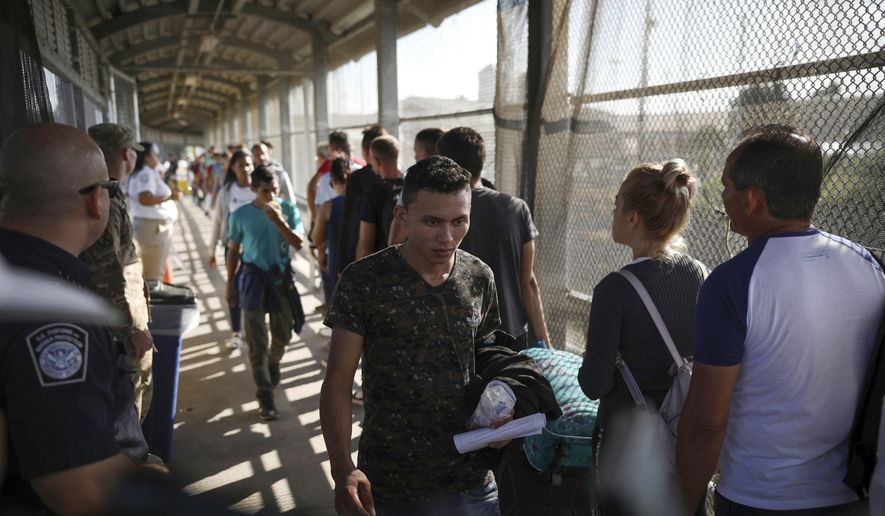The U.S. had just witnessed the worst month on record for illegal immigrant parents and children streaming across the southern border in May 2019, and an irate President Trump took to Twitter demanding Mexico do something about it — or else face crippling tariffs.
Top Mexican officials scurried to Washington to negotiate and emerged a year ago this week promising to deploy tens of thousands of national guard forces and expand the so-called Remain in Mexico policy by taking back more Central Americans who had used Mexico as a transit point.
Results were nearly instantaneous.
Mexico apprehended 81,000 migrants from June to September, up 46% compared with the year before.
Farther north, the Border Patrol went from catching 84,000 illegal immigrants traveling as families in May to just 42,000 in July. By January, it was fewer than 5,000.
Border Patrol holding facilities, designed to accommodate maybe 4,000 migrants, had been bursting with five times that number last May. By early this year, they were below 4,000.
The coronavirus has only accelerated those trends, with the Trump administration using a powerful public health law to immediately expel most unauthorized border crossers.
But officials say without the groundwork laid by last year’s negotiations with Mexico, COVID-19 could have been a border disaster.
Now, a year on, all sides in the debate are studying what went right and what didn’t.
Andrew R. Arthur, a former immigration judge who is now a resident fellow at the Center for Immigration Studies, said the deal with Mexico was a watershed in U.S. relations with its southern neighbors.
“For a long time, we’ve had this paternalistic attitude toward our regional partners. Trump has made them part of the conversation, has indicated to them that they play a role, that they have their own international obligations,” Mr. Arthur said. “This is forcing those countries to live up to their obligations.”
In particular, he said, Mexican President Andres Manuel Lopez Obrador is committed to curtailing the power of the cartels that control the illegal immigrant flow, and the Mexican people were getting fed up with their country being used as a transit point for Guatemalans, Hondurans and Salvadorans.
At the time, many analysts in the U.S. dismissed the agreement as insubstantial. Some doubted its existence until Mr. Trump waved a copy at reporters on the White House lawn.
The U.S. agreed to speed up asylum processing, while Mexico agreed to deploy its national guard to its southern border with Guatemala and to expand the Migration Protection Protocol, a U.S. program better known as “Remain in Mexico” because American authorities pushed asylum-seekers back across the border to wait in Mexico for their immigration hearings.
Both sides said they would revisit the issue after 45 days and 90 days. If things didn’t improve, Mr. Trump said, he reserved the right to impose the stiff tariffs he had threatened.
Instead, he found himself effusively praising Mexico.
The Migration Policy Institute, in its one-year analysis, said the deal has “marked a new chapter” in cooperation between the two countries, and in Mexico’s own efforts to patrol its territory.
“Recognized by both governments for successfully reducing irregular migration to the U.S.-Mexico border, the agreement also increased bilateral communication around migration, bolstered Mexico’s enforcement and humanitarian protection capacity, and helped identify significant institutional limitations,” wrote Ariel G. Ruiz Soto, the MPI analyst.
He said Mexico saw a surge in its own requests for humanitarian protection last year from nearly 30,000 to more than 70,000.
But he said it’s not clear whether Mexico’s own infrastructure is up to the task of accommodating those new humanitarian migrants or housing the ones the U.S. has sent back to wait under the MPP.
The MPP began even before last June’s deal but had been used for fewer than 10,000 people. The borderwide expansion to which Mexican authorities agreed last June paved the way for another 55,000 people over the next 10 months, according to the Transactional Records Access Clearinghouse.
Only a fraction of those cases had been heard by the time the coronavirus struck, putting a hold on the hearings.
Immigration rights advocates say making truly desperate and needy asylum-seekers wait in Mexico has been disastrous. Human Rights First, in a report last month, said it had documented 1,114 cases of murder, rape, kidnapping and other assaults on people sent back under the MPP.
The Washington Office on Latin America said Mr. Trump has now tied the stiff border policies to stopping the coronavirus, making them all the more potent — and wrong.
WOLA, in its one-year look-back, also questioned whether the policies won’t keep the numbers low for long.
“The border and migration restrictions and the economic downturn seen under COVID-19 doesn’t mean that long-term migration trends will grind to a halt; indeed, we predict an increase in migration as governments begin to lift restrictions,” WOLA said. “This makes it all the more urgent that both the United States and Mexico move away from deterrence-first migration policies that place migrants and asylum seekers at risk and curtail their ability to seek protection.”
Mr. Arthur also said the agreement is no substitute for Congress stepping in — though he added that lawmakers need to fix parts of U.S. law and court rulings that created the loopholes migrants used to take advantage of the situation.
“Until there actually is congressional action, we’re going to be relying on the Mexican government to control their border,” he said, adding that while they have their own incentives to do so, “you never know when public sentiment in Mexico’s going to change about this.”
• Stephen Dinan can be reached at sdinan@washingtontimes.com.




Please read our comment policy before commenting.